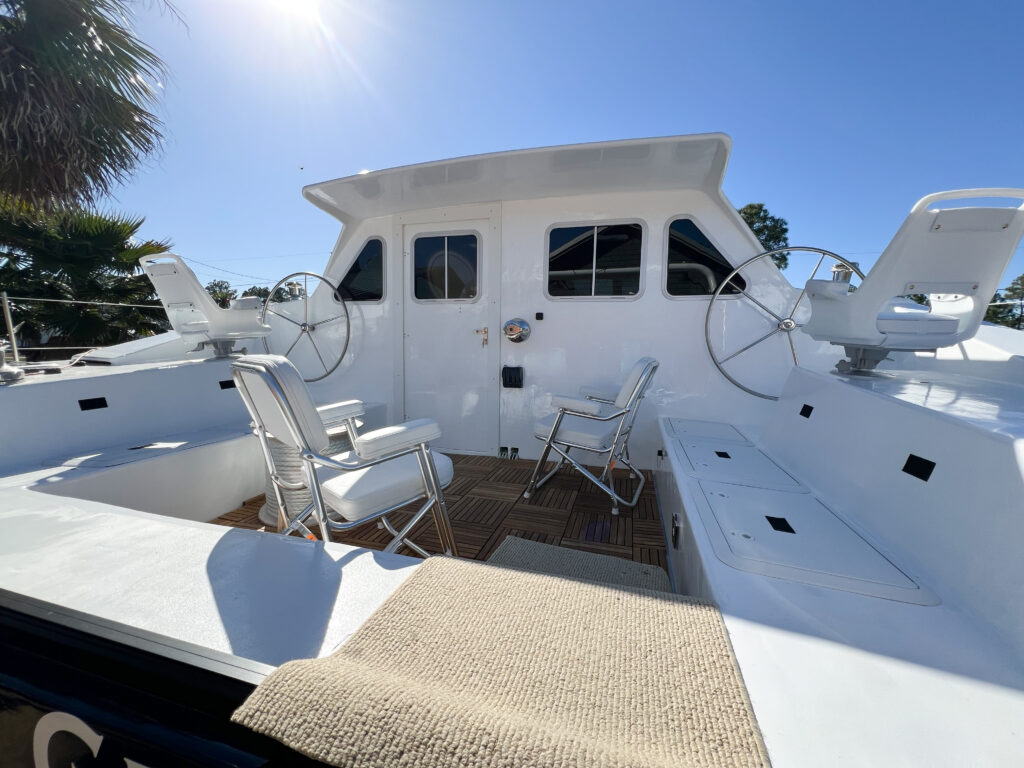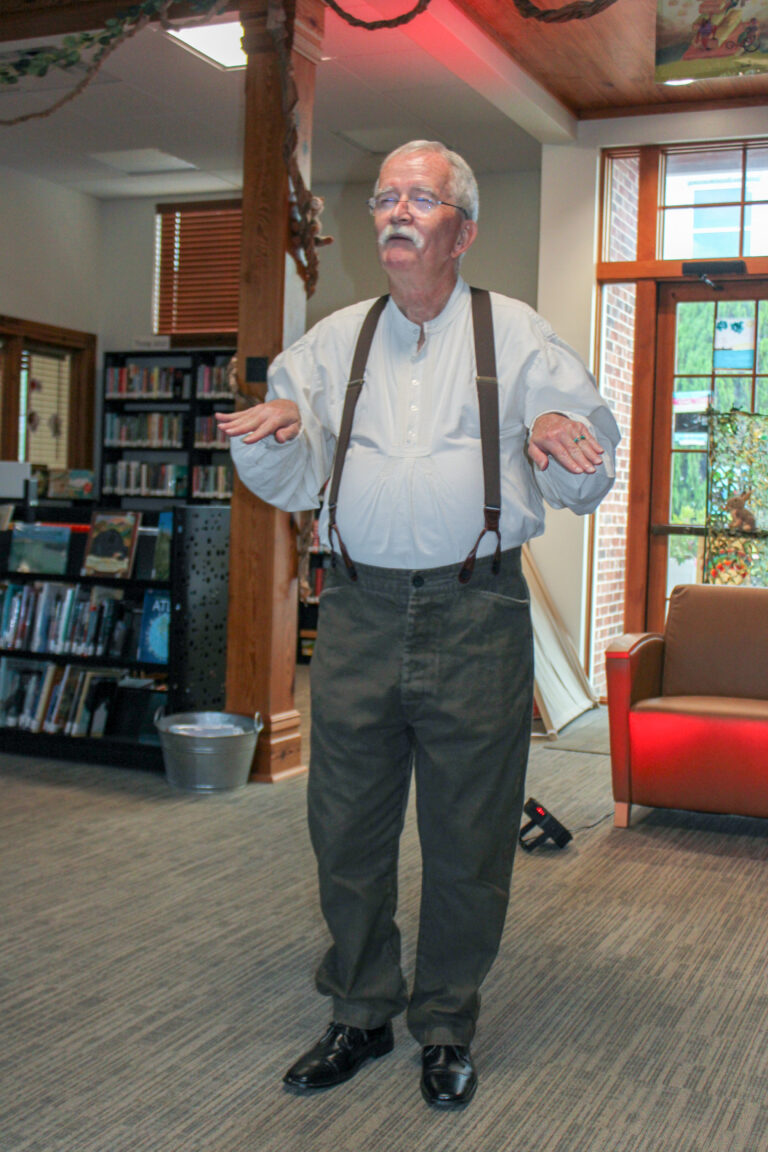Holcombe’s boat
‘Magnificent’ handmade catamaran to soon set sail
Two decades ago, Mike Holcombe and his wife Glynis built a home in the Jones Homestead area east of Port St. Joe.
At about the same time, Mike paid $2,000 to purchase a set of plans from famed New Zealand boat designer and builder Ian Farrier, known for his innovative multihull creations he built in Australia beginning in 1973.
When he was a young man, Mike had built an 11-foot boat but this time he wanted to take on something more ambitious.
“I decided it was not big enough,” he said. “I wanted a catamaran so it would sail flat, and I searched out different catamaran dealers and liked his plans. He gave so much instruction, a complete building manual and complete building plans.”
Mike bought the 25th set of plans for the Farrier F-41; the 39th set of plans was recently completed in Australia.
Mike set out to join this exclusive group, and 20 years later and within the next month, he will have arranged for Ducky Johnson to move this 23-foot by 43-foot catamaran, which now sits in front of his Palm Breeze Way home, to the White City boat launch.
There he’ll have Deep South cranes place the 54-foot mast into the hull, and the Glynis Grace will be ready to become not only the largest such boat in the county, but most importantly a testament to one man’s dedication and perseverance in building a boat that the inspector from the Florida Fish and Wildlife Conservation Commission called “magnificent” when he enthusiastically assigned it its hull identification number.
“They came and they were blown away,” said Glynis. “They said 90 percent of the time these boats are made from stolen or chopped-up other boats and put together.”
There’s nothing chopped-up or used about the components of the Glynis Grace, named for Mike’s wife as well their granddaughter Grace, a former Auburn University softball player who is about to receive her doctorate in physical therapy.
In sharp contrast, the fact is that as of last week, Glynis had calculated that her husband has spent more than $355,000 in plans, parts and pieces alone, not even considering the untold manhours that Mike invested in it.
“He has very expensive tastes, especially with electronics,” she said.
Mike, a native of Eastpoint, Georgia, also had the knowledge and wherewithal to take on this assignment. Both he and his wife had built nine homes over the years, two of them in the last 20 years, and each had run their own businesses.
An engineer by trade, Mike, 69, is retired from the electrical instrumentation controls business, and earlier in his career worked in the fiberglass industry, for Owens Corning, so he knew well the care needed to work with plastics and toxic applications.
He built a giant workshop, with proper ventilation, and he set about fabricating the Glynis Grace from hull to halyard.
First on his agenda was the monumental task of shaping the main ingredient, bending 4-foot by 8-foot sheets of structural foam into shape in a form frame, then laminating them and removing them from the frame, and sandwiching them between layers of fiberglass.
“Nothing is straight,” said Glynis. “Everything on the boat is beautifully curved, all done with that foam.”
After that it’s a matter of sanding and faring the hull, making it smooth and ensuring that the curves all look good.
“Every curve on this boat is magnificent,” said Glynis.
Once the two hulls were done, Mike set about creating the cabin between them, complete with kitchen, navigational equipment and a cockpit just outside there that has two steering wheels.
The Glynis Grace does not rely on diesel but two electric motors that enable the massive watercraft to move in and out of the harbor before the sails are hoisted. Plus there is a reverse osmosis system that turns saltwater into fresh.
In addition there are five different winches, an electric one in the main cockpit that can raise and lower all the sails, and two manual ones that control the jib, and two on the aft side that control the traveler, which controls the boom. and the screecher, which is a smaller spinnaker-reacher, designed to sail both upwind and downwind.
“Mike is a master electrician, just the wiring on this boat is magnificent,” said Glynis. “The bank of batteries is unbelievable.”
In order to fully equip the Glynis Grace a lot more had to be done, everything from applying a hull blanket that had to be glued to the fiberglass, so as to soften and protect it when things bump into the walls.
Along with creating two state rooms, each with a queen size bed, a hanging locker, a fan and a hatch over the bed so travelers can gaze up at the stars while lying together at night, there were showers and bathrooms and a kitchen to create.
“Every single part of this part had to be hand fabricated,” said Glynis. “The shower was handmade.”
While she helped out with the interior, Glynis, married to her one and only for 50 years, is quick to stress that while “we work very well together but we don’t work quickly,” she has been a lesser cog in her husband’s wheelhouse, working on things like creating the pillows and bench cushions in the nautical colors of navy blue, scarlet and bright white
“I fed him lunch. that’s about the extent of it,” she said. “Mike built that with his own hands; this is his passion, this is his baby. We’ve always been goalsetters and this was one of his goals.”
Not everything went smoothly, most notably the 54-foot Sparcraft aluminum mast that was brought in from Charlotte, North Carolina. “Their driver loaded them up and put it on an old trailer with no cushioning or support that held the mast in place,” Glynis said.
So, with metal banging against metal, the mast arrived with four huge gouges in it, and so it had to be sent back to Charlotte. “They took it back and they had to acid bathe it to de-anodize it and then they had to repair it and re-anodize it,” she said.
One thing that the Glynis Grace is going to have is speed, a characteristic of Farrier watercraft. Mike said that among the first ones built in Australia sailed at 20 knots in a 20-knot wind, the equivalent of 23 miles per hour.
As fast as the boat can go, the Holcombes plan to slow down their lives once the Glynis Grace sets sail. They plan on venturing to the Keys every winter, and “we may ease down into the Bahamas and Caribbean. We like the Dry Tortugas.”
When the Glynis Grace is soon launched, Mike’s mom won’t be there to see share in her son’s achievement, as she passed away last month at the age of 89.
But she no doubt shared the pride in her son, as will anyone looking out on the magnificent watercraft with its home port of Port St. Joe emblazoned on the name board.
“It’s a landmark for Gulf County and will have a home out on the bay,” Glynis said. “It’s not just its home, it was built here, a lifetime achievement by one man.”








Meet the Editor
David Adlerstein, The Apalachicola Times’ digital editor, started with the news outlet in January 2002 as a reporter.
Prior to then, David Adlerstein began as a newspaperman with a small Boston weekly, after graduating magna cum laude from Brandeis University in Waltham, Massachusetts. He later edited the weekly Bellville Times, and as business reporter for the daily Marion Star, both not far from his hometown of Columbus, Ohio.
In 1995, he moved to South Florida, and worked as a business reporter and editor of Medical Business newspaper. In Jan. 2002, he began with the Apalachicola Times, first as reporter and later as editor, and in Oct. 2020, also began editing the Port St. Joe Star.